Luchi, a renowned Bengali bread made from flour, is a deep-fried delicacy that inflates when cooked. Now, let me guide you on crafting flawless fulko loochi in the comfort of your own home.
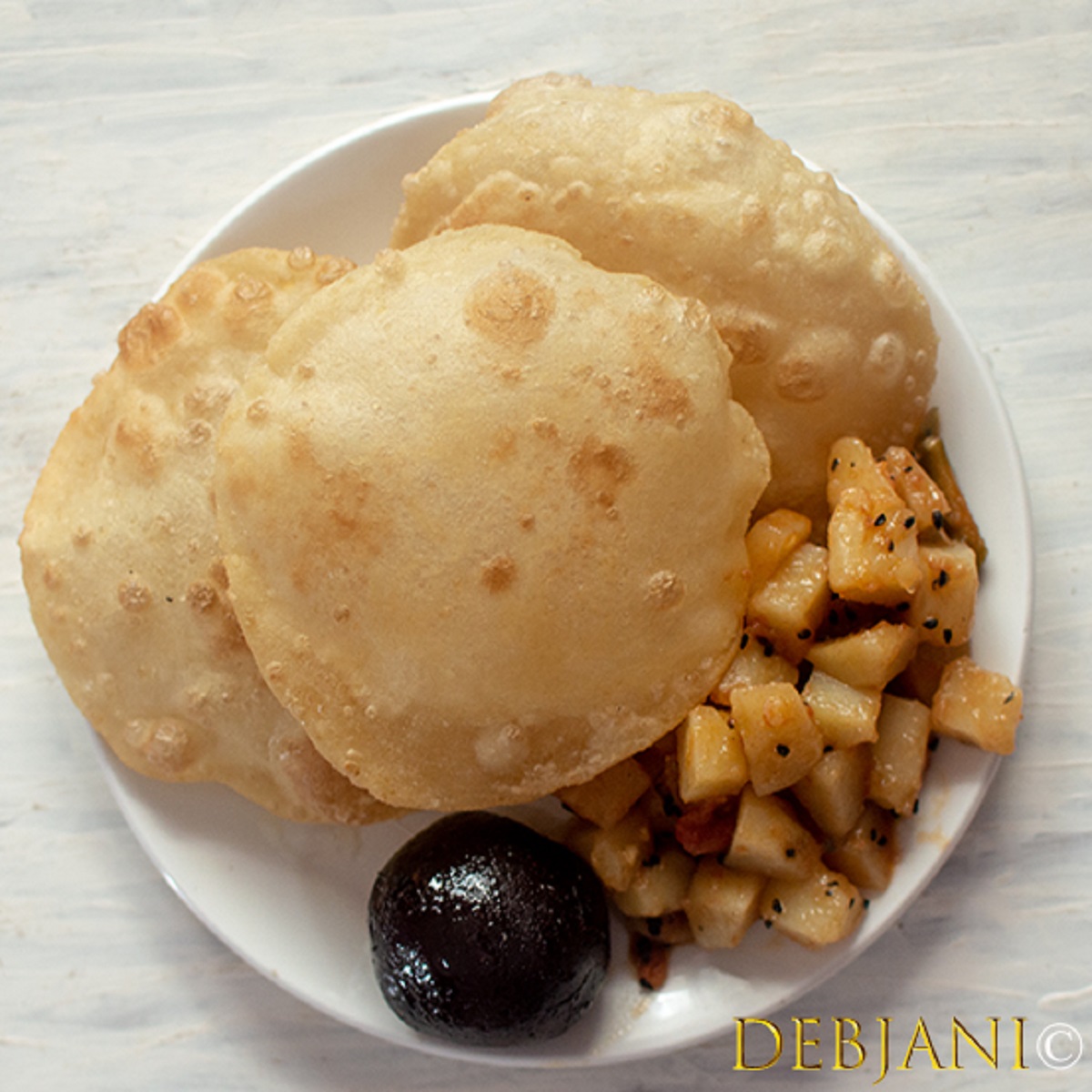
Jump to:
- Some Funny Bengali Things about perfect Phulko Luchi
- Gorom Luchi and Jawlkhabar
- Types!
- Bengali Luchi Tips! 2.5 Strokes to get it done!
- Frequently Asked Questions
- Here's how you make Perfect Bengali Phulko Luchi
- Similar Recipes
- Side Dishes from Debjanir Rannaghar
- Have you tried the Luchi Recipe from Debjanir Rannaghar!
- Here's the perfect Luchi recipe Pin for your Pinterest board
Some Funny Bengali Things about perfect Phulko Luchi
- The Bengali middle-aged woman torments her husband on a Sunday morning by limiting the number of Luchi he can have, reminding him of his blood pressure.
- The Bengali middle-class husband lovingly feeds his wife a puffed loochi while she busily prepares the same for the whole family. After all, a delicious loochi can express love and affection!
- The newlyweds' unsuccessful attempt at making perfectly round and puffed luchis, or even making them together! Some may call it cooking, but it's really about building the foundation of their relationship.
- The girl or boy's first job outside the city, followed by their first attempt at making luchis after calling and asking their mother for guidance. It's a phase of self-pity and longing.
- The Biyebari celebration begins with a delightful Loochi Bonde Jolkhabar in the morning!
- Lastly, enjoying Bashi Luchee (leftover) with Payesh, the perfect ending to a meal.
There are countless stories to be told about the deep affection Bengalis have for the perfect luchi. Luchi is more than just food, it evokes strong emotions. If you have any additional luchi tales, please share them with me. I would be delighted to include them in my collection.
Gorom Luchi and Jawlkhabar
What other title can capture the essence of this post? Loochi sums it up. Initially, I considered using "how to make authentic luchi," but I realized that the word alone conveys the emotion. Loochi, the beloved traditional deep-fried flatbread of Bengal, is not the same as Poori. Allow me to clarify without confusing you, or perhaps I can entice you with a few loochi, the epitome of a Bengali main course.
Is there a single Bengali household that doesn't indulge in loochi occasionally for Jolkhabar, Dinner, or even lunch? Let me assure you, Bengali Jolkhabar is far more than a sophisticated breakfast.
The art of making perfect fulko Luchi!
Luchi, the famous deep-fried flatbread in the Bengali style, is made from flour, commonly known as Maida or all-purpose flour. Its signature whitish color is unmistakable. Needless to say, it is a deep-fried delight.
I vividly recall asking Mammam (my aunt) about the process of making perfect luchi. Growing up in a North Calcutta household, spending time at my Didar Bari and her ancestral home in Birbhum, and eventually marrying into a Bengali Muslim family, I have savored and witnessed various types of luchi.
At my home, we enjoy luchi made with all-purpose flour. At my grandmother's birthplace, we savor loochi made with a combination of whole wheat flour and all-purpose flour. we relish moidar luchi fried in ghee, which is known as ghee-er luchee at my grandmother's home, . And lastly, at my in-laws' place, we indulge in atar luchi made solely with whole wheat flour. Surprisingly, each variation is distinct but equally delicious.
Types!
While maidar luchi is the most common version, ata-moidar loochi is just as delightful, with atar loochi being the most rustic and ghee-er luchee being the richest form. I must also mention another important variation called taka loochi, which my grandmother used to make.
In this post, I will share the process of making moidar loochi. I learned a trick from my mother, which I still follow when making this particular type of flatbread. My mother used to say, "the key to achieving perfectly puffed loochi lies in the dough shaping process! It should be done in 2.5 strokes! One, two, and a half!" I apologize if I have confused you. Allow me to explain further.
Bengali Luchi Tips! 2.5 Strokes to get it done!
Luchi is a type of bread that is deep-fried until it puffs up. The key to achieving the perfect puff lies in properly preparing the dough, which I will explain in detail below. However, the real secret to achieving a soft and puffed luchi lies in the rolling technique, which follows the rule of 2.5. By using specific strokes, such as one, two, and a half, you can create the ideal luchi.
In the past, luchi was traditionally fried in ghee, but nowadays, those of us who are mindful of our calorie intake prefer to use vegetable oil instead. However, a small amount of ghee can enhance the flavor, so I like to incorporate a little bit into the dough and the oil, allowing my luchi to absorb its delicious taste.
Frequently Asked Questions
No, these two are slightly different. The variation lies in the texture of the dough and the thickness of the rolled dough. Typically, poori is made with whole wheat flour, while luchi is made with all-purpose flour or a combination of atta and maida, sometimes even just atta.
Loochi can indeed be made with whole wheat flour. Just ensure that the dough is kneaded enough to form gluten and contains the necessary amount of moyan. In certain districts of West Bengal, luchi is often made with atta as well. However, the most common and popular form is maida loochi, which is white in color and not excessively oily.
Moyan dewa refers to the process of adding oil or ghee to the dough while kneading it. This helps in making the fried bread slightly crispy (khasta) and prevents it from absorbing too much oil during frying.
Yes and no.
The likelihood of ending up with dense, unleavened bread increases with each roll of the dough before frying.
The possibilities are endless. If you're looking for a vegetarian option for breakfast, try pairing luchi with aloo chorchori. For a delicious dinner, consider the combination of luchi-aloor dum or loochi ghughni. When it comes to non-vegetarian options, you can't go wrong with the combination of luchi kosha mangsho (or Chicken Kosha) or loochi and dimer dalna. Lastly, don't forget to try the combination of luchi and payesh and let me know your thoughts.
Here's how you make Perfect Bengali Phulko Luchi
Print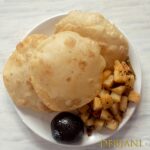
Luchi
- Total Time: 45 mins
- Yield: 30 pieces 1x
- Diet: Vegetarian
Description
In this blogpost, you will discover a step-by-step guide on how to prepare the delectable fulko luchi, a renowned fried bread from Bengal.
Ingredients
To make the Dough:
- 500g All-purpose Flour/ Maida
- 2 Tbsp. Ghee
- ½ Tsp. Salt
- 200ml Water to knead the dough
To Fry:
- 250ml Vegetable Oil for Deep Frying
- 1 Tbsp. Ghee
Instructions
- Take Maida along with salt in a deep bowl and mix.
- Now add Ghee and mix using the finger. The End product should be a crumbly mixture. This is called "Moyen Dewa".
- Be available with 200ml of warm water.
- Now add water little by little and knead the flour to form the dough.
- The dough must not be soft but not stiff as well. You may refer to the picture.
- You may not need to use the entire water.
- Keep in mind that you need to knead the dough properly so that it can form gluten. This means once done, the dough will be soft but will not stick to the bowl or plate using for kneading.
- Cover the dough with a wet cloth and leave for 15 minutes to give it rest.
- Now take the dough and make small 2" size balls out of it.
- Take 1 Tbsp. oil in a bowl and keep it behind the rolling plate.
- Take one ball and apply little oil to it and flatten the ball on the rolling plate.
- Now using the Rolling pin roll the ball into a small disk.
- Here, you must not roll vigorously and try to keep the rolling to 2.5 strokes.
- In the meantime, heat the oil in a deep pan along with the Ghee.
- Now Put one flattened flour disk in the mid of the pan.
- Lower the flame to medium.
- Using a spatula press it a bit. It will help it to puff.
- Turn it and fry the other side as well.
- The color should be near creme' but not brown which means no over-frying at all.
- Strain it from the oil and fry the rest of the Luchi in the same manner.
Notes
- Ghee is not necessary, but it adds great taste. If you're not concerned about calories, you can substitute ghee for oil.
- When preparing the dough, you have the option to use oil instead of ghee. Avoid kneading the dough too hard.
- Apply a small amount of oil when rolling out the dough, but avoid using dry flour as it will cause the loochi to turn brown instead of white.
- Prep Time: 15 mins
- Cook Time: 30 mins
- Category: Main
- Method: frying
- Cuisine: Bengali
Nutrition
- Serving Size: 30g
- Calories: 136
- Sugar: 0.1g
- Sodium: 39mg
- Fat: 8.7g
- Saturated Fat: 2.1g
- Carbohydrates: 12.7g
- Fiber: 0.5g
- Protein: 1.7g
- Cholesterol: 2mg
Similar Recipes
Side Dishes from Debjanir Rannaghar
- Kosha Mangsho (also known as Bengali Mutton Kasha)
- Bengali Desi Murgir Dum (also known as Bengali Country Chicken Curry)
- Natun Aloor Dum (also known as Bengali Niramish Aloor Dum)
- Narkel diye Cholar Dal (also known as Bengali Cholar Dal
- Chanar Dalna (also known as Bengali Cottage Cheese and Potato Curry)
- Paneer er Dalna (also known as Niramish Paneer Er Torkari)
- Dimer Dalna (also known as Bengali Egg Curry with Potato)
- Aloo Phulkopir Dalna (also known as Phulkopi Aloor Dalna)
Have you tried the Luchi Recipe from Debjanir Rannaghar!
Do let me know how it came out. Also, I would love to see a picture of the same which you can share here at dolonchttrj@gmail.com. On Instagram, you can use my hashtag #debjanirrannaghar or can tag me at @foodofdebjani.
You can follow me on Facebook, Twitter, Pinterest, and Instagram for updates and recipes from Debjanir Rannaghar.
Here's the perfect Luchi recipe Pin for your Pinterest board
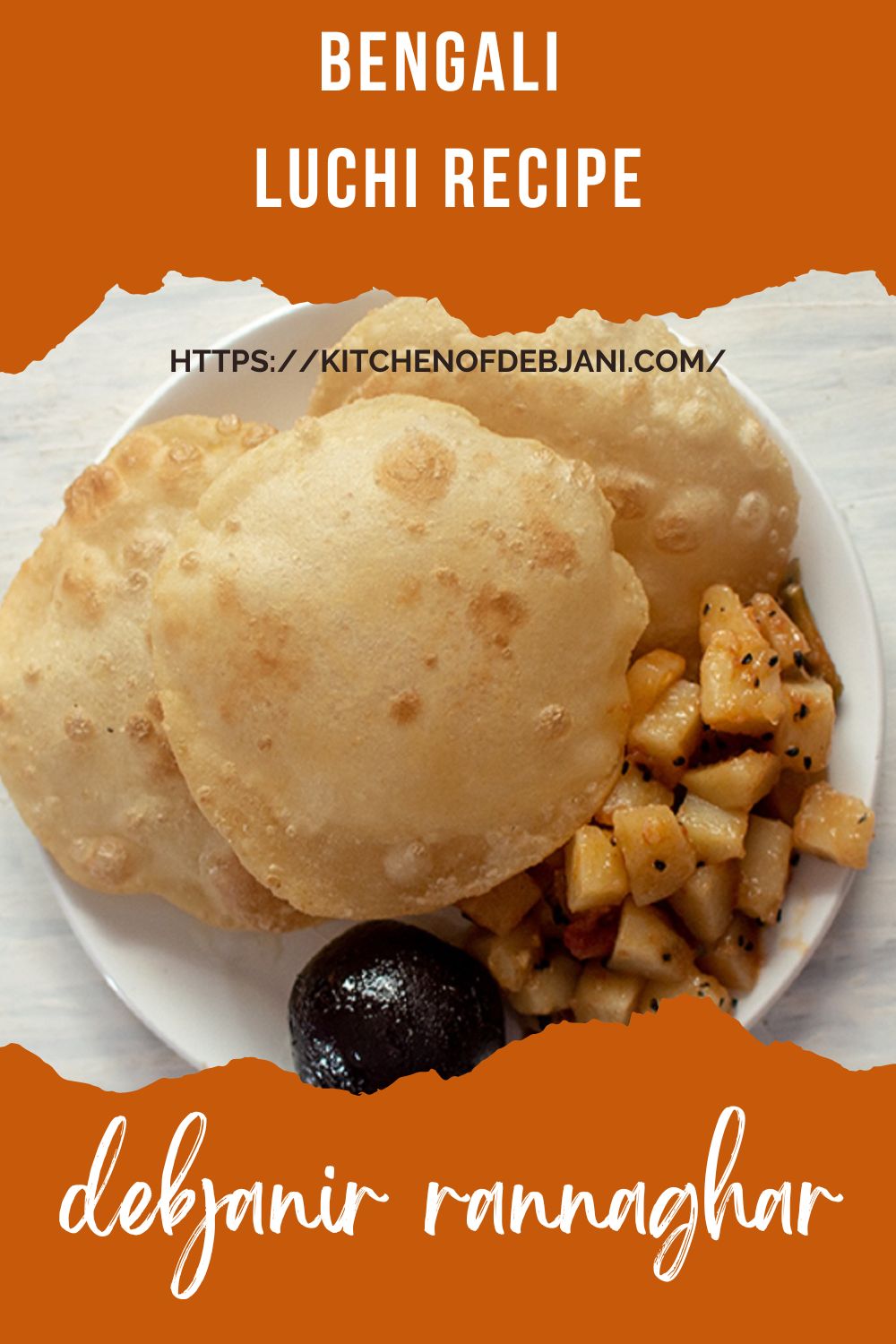

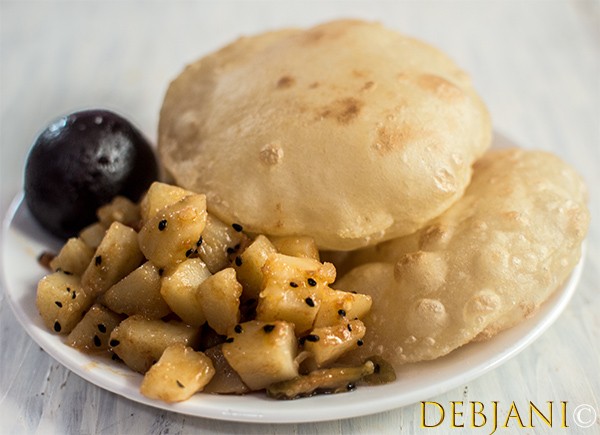

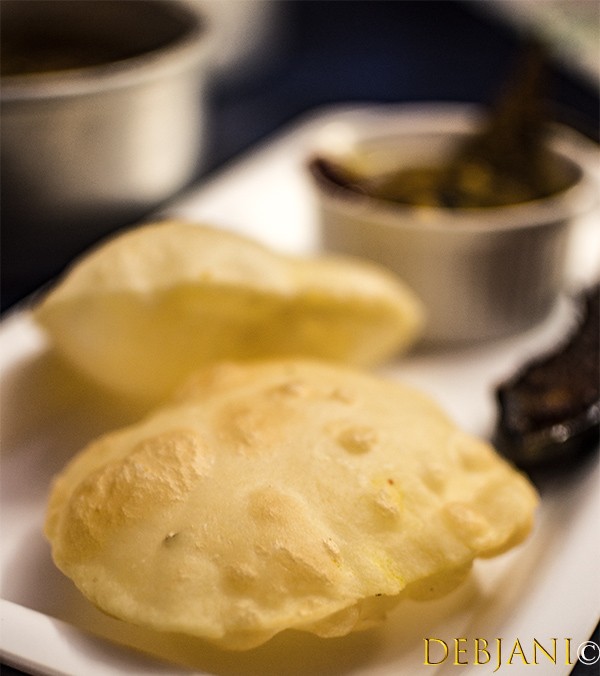
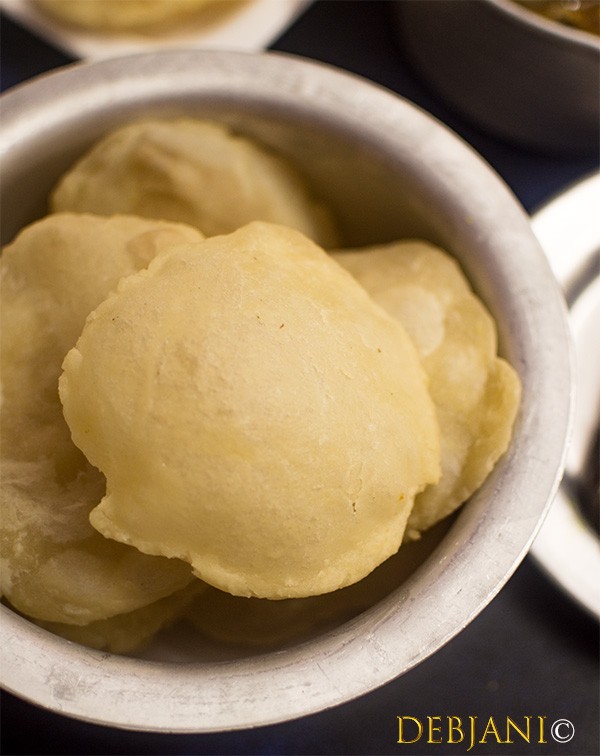
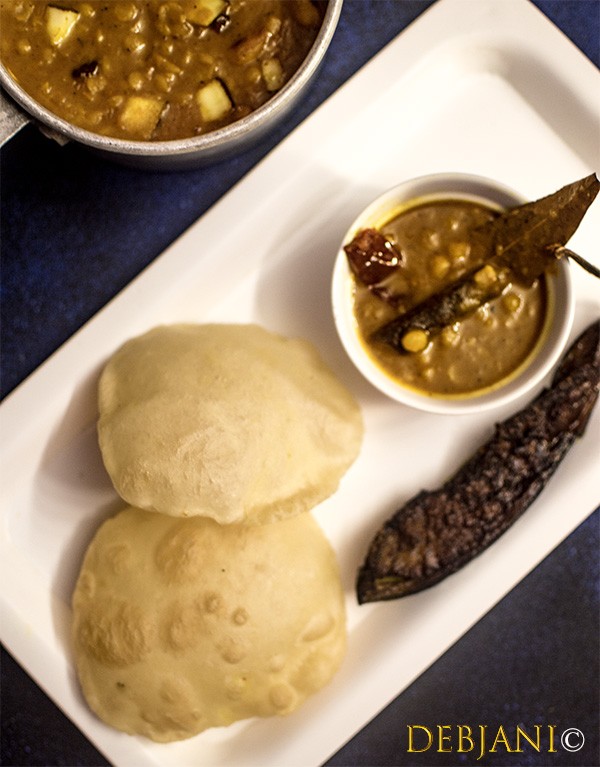


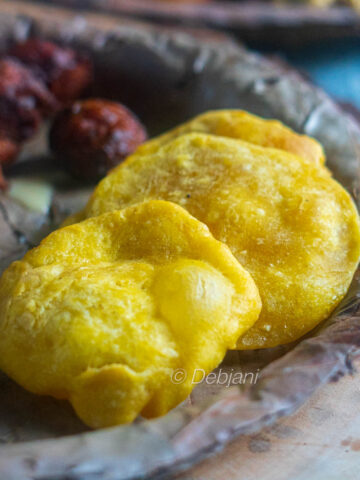
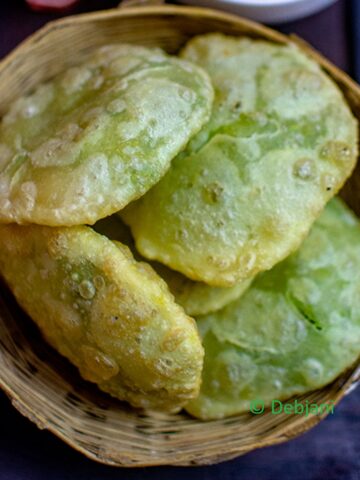
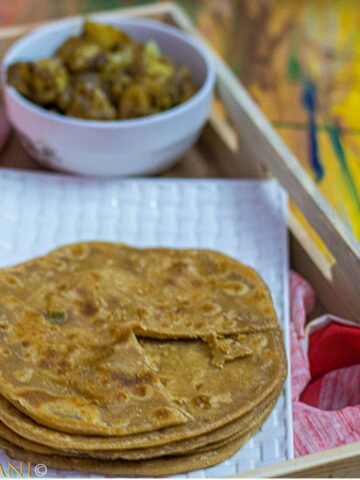



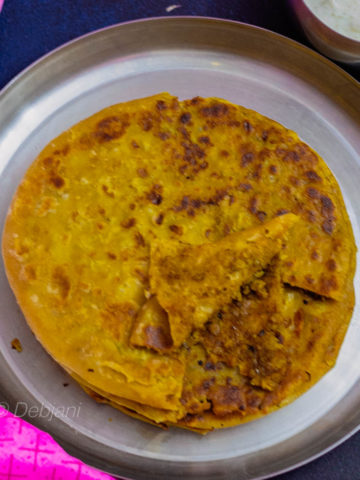
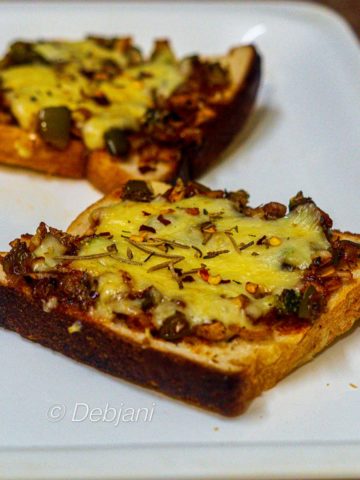
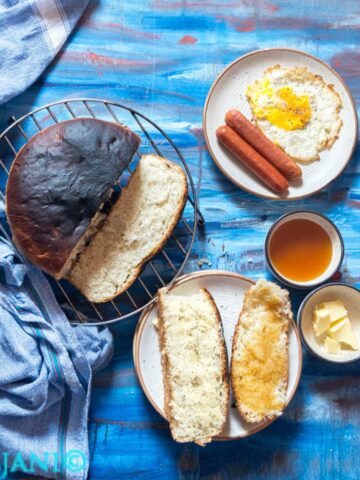
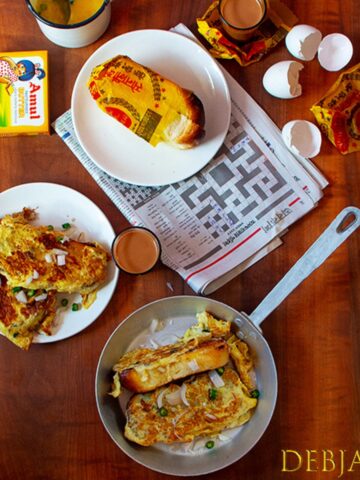
Nathline Dias (Ms.) says
Dear Debjani, I tried your Cholar Dal recipe with the Luchi recipe. I have tasted such a tasty dal for the first time. I am a non-vegetarian and we usually find vegetarian food less tastier than meat and fish. I am trying to give up meat and fish. Your tasty recipes will help me on my route.
Thank you very much!!
Debjani says
Dear Natiline!
thank you so much for your kind words. I am glad that this recipe works for you.